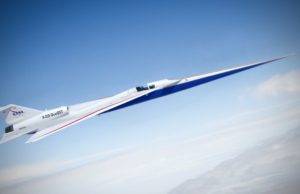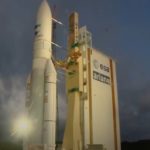Lockheed Martin has released an image of the first prototype of the X-59 Quiet SuperSonic Technology (QueSST) which it is building in a partnership with NASA.
The image was taken at the start of the final assembly process at the Lockheed Martin Skunk Works advanced projects bureau. The X-59 will measure 96 feet long, have a span of 29.5 feet, reach speeds of Mach 1.4, and fly at an altitude of 55,000 feet.
Initial flight tests are set to take place in 2022. In 2023, NASA will fly the X-59 over the test range at the agency’s Armstrong Flight Research Center in California to prove it can produce a quieter sonic boom and is safe to operate in the National Airspace System. Aircraft noise will be measured by 175 ground recording systems.
Data will be collected on acceptability of ‘quiet sonic boom’
Community response data on the acceptability of a quiet sonic boom generated by the aircraft. The data will help NASA provide regulators with the information needed to establish an acceptable commercial supersonic noise standard, a ban on commercial supersonic travel is currently in place over land. NASA has previously reported that the plane should generate a noise no louder than a car door being shut.
In 2024, NASA will fly the X-59 over several communities across the USA with data collected to be given to the Federal Aviation Administration and the International Civil Aviation Organization for their consideration in changing the existing bans on supersonic flight over land.
Lifting ban on supersonic flight over land could open up global market
A ban on supersonic travel over land has been in effect in 1973 and has restricted faster-than-sound travel only to flights over the ocean, including the operation of the Concorde service by British Airways and Air France between 1976 and 2003.
Lifting of the ban would open up the global market for aircraft manufacturers, enabling passengers to travel anywhere in the world in half the time it takes today. The X-59, which is single-piloted, will never carry passengers, but aircraft manufacturers may choose to incorporate its technology into their own designs.

